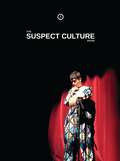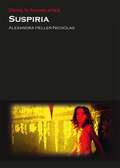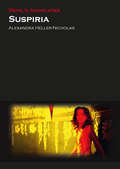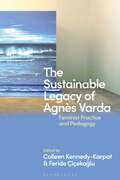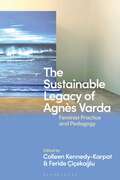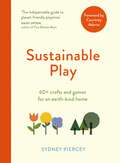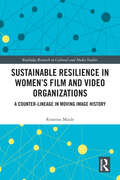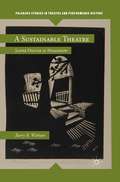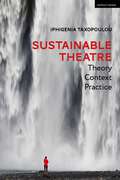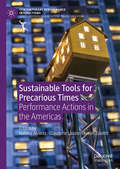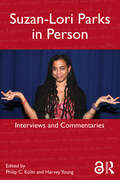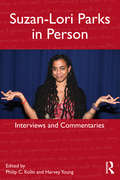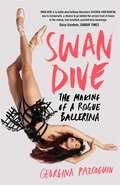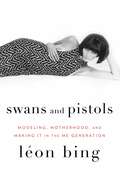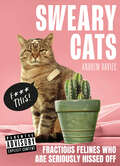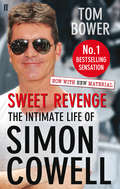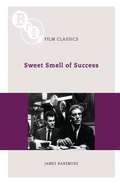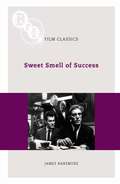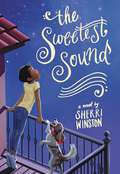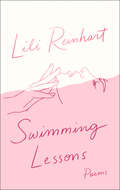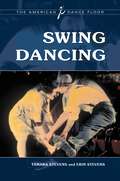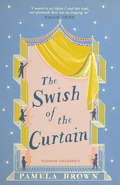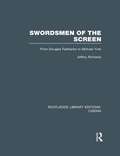- Table View
- List View
The Suspect Culture Book
by Dan Rebellato Graham Eatough David Grieg‘Considering its track record in collaborative and interdisciplinary work, its international status, and its reputation for innovative practice […] Suspect Culture has been and remains one of our most innovative arts companies and as such it is among our most precious.’ Trish Reid Suspect Culture was one of the UK’s leading experimental theatre companies between 1993 and 2009. Over the course of its 16-year history the company, based in Glasgow, worked with some of the most respected artists and organizations in the UK and internationally, and is seen to have made a significant contribution to the British theatre scene of the 1990s and 2000s. Described by Scotland on Sunday as Scottish theatre’s major creative powerhouse and by The Times as the most adventurous, most in-tune-with-the-times theatre company in Britain, Suspect Culture have had a quietly decisive impact on British theatre. The Suspect Culture Book offers a comprehensive survey of the company’s history and ideas and features contributions from its most important artists and critics. Edited by Artistic Director Graham Eatough and playwright/academic Dan Rebellato and lavishly illustrated throughout, the book offers multiple international perspectives on Suspect Culture alongside previously-unpublished playtexts of three of its most celebrated shows, Timeless, Mainstream and Lament (all created by the company with text by David Greig).
Suspiria (Devil's Advocates)
by Alexandra Heller-NicholasAs one of the most globally recognisable instances of 20th century Eurohorror, Dario Argento's Suspiria (1976) is poetic, chaotic, and intriguing. The cult reputation of Argento's baroque nightmare is reflected in the critical praise it continues to receive almost 40 years after its original release, and it appears regularly on lists of the greatest horror films ever. For fans and critics alike, Suspiria is as mesmerising as it is impenetrable: the impact of Argento's notorious disinterest in matters of plot and characterisation combines with Suspiria's aggressive stylistic hyperactivity to render it a movie that needs to be experienced through the body as much as through emotion or the intellect. For its many fans, Suspiria is synonymous with European horror more broadly, and Argento himself is by far the most famous of all the Italian horror directors. If there was any doubt of his status as one of the great horror auteurs, Argento's international reputation was solidified well beyond the realms of cult fandom in the 1990s with retrospectives at both the American Museum of the Moving Image and the British Film Institute. This book considers the complex ways that Argento weaves together light, sound and cinema history to construct one of the most breathtaking horror movies of all time, a film as fascinating as it is ultimately unfathomable.
Suspiria (Devil's Advocates)
by Alexandra Heller-NicholasAs one of the most globally recognisable instances of 20th century Eurohorror, Dario Argento's Suspiria (1976) is poetic, chaotic, and intriguing. The cult reputation of Argento's baroque nightmare is reflected in the critical praise it continues to receive almost 40 years after its original release, and it appears regularly on lists of the greatest horror films ever. For fans and critics alike, Suspiria is as mesmerising as it is impenetrable: the impact of Argento's notorious disinterest in matters of plot and characterisation combines with Suspiria's aggressive stylistic hyperactivity to render it a movie that needs to be experienced through the body as much as through emotion or the intellect. For its many fans, Suspiria is synonymous with European horror more broadly, and Argento himself is by far the most famous of all the Italian horror directors. If there was any doubt of his status as one of the great horror auteurs, Argento's international reputation was solidified well beyond the realms of cult fandom in the 1990s with retrospectives at both the American Museum of the Moving Image and the British Film Institute. This book considers the complex ways that Argento weaves together light, sound and cinema history to construct one of the most breathtaking horror movies of all time, a film as fascinating as it is ultimately unfathomable.
The Sustainable Legacy of Agnès Varda: Feminist Practice and Pedagogy
by Colleen Kennedy-Karpat and Feride ÇiçekoğluDrawing especially on the encounters and relationships that defined her exceptional career, The Sustainable Legacy of Agnès Varda outlines a sustainable legacy for the celebrated director and visual artist. Over nine chapters, it unpacks how creation, connection, and environment form the core of Varda's artistry, which centers foremost on relationships with her family, with other artists, even with passersby she would meet in her travels around the world. Also celebrating her feminist legacy, the chapters cover a wide range, from the classic Cléo from 5 to 7 (1962) to documentaries The Beaches of Agnès (2008) and Faces Places (2017) as well as selected art installations. The book's final section is dedicated to teaching Varda's work; here, ten scholars from around the world consider how Varda's art and feminist pedagogies offer unique ways to bring crucial concepts into the classroom. By seeking a sustainable praxis to discuss and teach Varda's work, and by making pedagogical concerns an explicit part of this approach, this book argues that Varda's insights about the nature of creative work will inspire new generations of viewers and audiences.
The Sustainable Legacy of Agnès Varda: Feminist Practice and Pedagogy
Drawing especially on the encounters and relationships that defined her exceptional career, The Sustainable Legacy of Agnès Varda outlines a sustainable legacy for the celebrated director and visual artist. Over nine chapters, it unpacks how creation, connection, and environment form the core of Varda's artistry, which centers foremost on relationships with her family, with other artists, even with passersby she would meet in her travels around the world. Also celebrating her feminist legacy, the chapters cover a wide range, from the classic Cléo from 5 to 7 (1962) to documentaries The Beaches of Agnès (2008) and Faces Places (2017) as well as selected art installations. The book's final section is dedicated to teaching Varda's work; here, ten scholars from around the world consider how Varda's art and feminist pedagogies offer unique ways to bring crucial concepts into the classroom. By seeking a sustainable praxis to discuss and teach Varda's work, and by making pedagogical concerns an explicit part of this approach, this book argues that Varda's insights about the nature of creative work will inspire new generations of viewers and audiences.
Sustainable Play: 60+ cardboard crafts and games for an earth-kind home
by Sydney Piercey'I adore Sydney's approach to play... good for our planet, and good for our souls too.' - Daisy Upton, author of Five Minute Mum'For some serious playtime inspiration follow Sydney Piercey. She does it with zero fuss or show off. She is just brilliant'. -Clover StroudParenting blogger and mother-of-three, Sydney Piercey, gained traction online with her environmentally friendly DIY toys made entirely out of cardboard.Filled with 60+ creative, accessible and plastic-free projects and play ideas, Sustainable Play is packed with crafts and games to enjoy with your children on slow, rainy or drawbridge days at home. Sydney provides you with budget-friendly, easy-to-follow ideas to play and create in this handbook, inspired by her family's love of the simple things. From step-by-step projects to create magical toys from your leftover cereal boxes to joy-filled games using everyday objects from around your home, Sustainable Play will equip you with the inspiration you need to entertain your children in a creative, stimulating and sustainable way - being kind to the planet in the process.
Sustainable Resilience in Women's Film and Video Organizations: A Counter-Lineage in Moving Image History (Routledge Research in Cultural and Media Studies)
by Rosanna MauleThis book illustrates a distinctive lineage of critical interventions in moving image culture and in the public sphere through the trajectories of a small number of film and video organizations established between the 1970s and the early 1980s in Western Europe and North America mainly by women and still operative today. The six case studies examined (Drac Màgic, Women Make Movies, Groupe Intervention Vidéo, Leeds Animation Workshop, bildwechsel, Centre Audiovisuel Simone de Beauvoir) have maintained a discrete yet continuing presence within an audiovisual industry and a cultural system dominated by institutionalized, state-funded, and corporate forms of audiovisual production and distribution. Their longevity—quite a rarity in the independent circuit—makes a strong case for the sustainability of feminist/LGBTQ media activism in the public sphere, in spite of its low-key profile. This volume will be of interest to academicians of history and communication studies, feminist and LGBTQ topics and gender-related cinematic culture.
Sustainable Resilience in Women's Film and Video Organizations: A Counter-Lineage in Moving Image History (Routledge Research in Cultural and Media Studies)
by Rosanna MauleThis book illustrates a distinctive lineage of critical interventions in moving image culture and in the public sphere through the trajectories of a small number of film and video organizations established between the 1970s and the early 1980s in Western Europe and North America mainly by women and still operative today. The six case studies examined (Drac Màgic, Women Make Movies, Groupe Intervention Vidéo, Leeds Animation Workshop, bildwechsel, Centre Audiovisuel Simone de Beauvoir) have maintained a discrete yet continuing presence within an audiovisual industry and a cultural system dominated by institutionalized, state-funded, and corporate forms of audiovisual production and distribution. Their longevity—quite a rarity in the independent circuit—makes a strong case for the sustainability of feminist/LGBTQ media activism in the public sphere, in spite of its low-key profile. This volume will be of interest to academicians of history and communication studies, feminist and LGBTQ topics and gender-related cinematic culture.
A Sustainable Theatre: Jasper Deeter at Hedgerow (Palgrave Studies in Theatre and Performance History)
by B. WithamBegun as an audacious experiment, for thirty years the Hedgerow Theatre prospered as America's most successful repertory company. While known for its famous alumnae (Ann Harding and Richard Basehart), Hedgerow's legacy is a living library of over 200 productions created by Jasper Deeter's idealistic and determined pursuit of 'truth and beauty.'
Sustainable Theatre: Theory, Context, Practice
by Iphigenia TaxopoulouHow does the world of theatre and the performing arts intersect with the climate and environmental crisis? This timely book is the first comprehensive account of the sector's response to the defining issue of our time.The book documents a sector in transition and presents theatre professionals, practitioners and organizations with a synthesis of information, knowledge and expertise to guide them to their own endorsement of sustainable thinking and practice. It is illustrated with inspiring case studies and interviews, from London's National Theatre, to Sydney Theatre Company, to the Göteborg Opera and the American Repertory Theatre. These foreground the work of pioneering institutions and individual practitioners whose artistic ingenuity, creative activism and sense of public mission have given shape, content and purpose to what we can now call 'sustainable theatre'.Spanning almost three decades, the book approaches the topic from multiple angles and through an international perspective, recording how climate and environmental concerns have been expressed in cultural policy, arts leadership and organizational ethics; in the greening of infrastructure and daily operations; in the individual and institutional practice of sustainable theatre-making; in performing arts education; and in touring practices and international collaboration. It investigates, too, how the climate crisis influences theatre as a story-teller – on stage and beyond.Written by a leading expert in the field of culture and environmental sustainability and distilling many years of research and hands-on experience, Sustainable Theatre: Theory, Context, Practice is intended to be relevant and useful to professionals involved in the theatre and performing arts sector in many different capacities: from policy-makers, arts leaders and managers to administrators, technicians, artists, scholars and educators.
Sustainable Theatre: Theory, Context, Practice
by Iphigenia TaxopoulouHow does the world of theatre and the performing arts intersect with the climate and environmental crisis? This timely book is the first comprehensive account of the sector's response to the defining issue of our time.The book documents a sector in transition and presents theatre professionals, practitioners and organizations with a synthesis of information, knowledge and expertise to guide them to their own endorsement of sustainable thinking and practice. It is illustrated with inspiring case studies and interviews, from London's National Theatre, to Sydney Theatre Company, to the Göteborg Opera and the American Repertory Theatre. These foreground the work of pioneering institutions and individual practitioners whose artistic ingenuity, creative activism and sense of public mission have given shape, content and purpose to what we can now call 'sustainable theatre'.Spanning almost three decades, the book approaches the topic from multiple angles and through an international perspective, recording how climate and environmental concerns have been expressed in cultural policy, arts leadership and organizational ethics; in the greening of infrastructure and daily operations; in the individual and institutional practice of sustainable theatre-making; in performing arts education; and in touring practices and international collaboration. It investigates, too, how the climate crisis influences theatre as a story-teller – on stage and beyond.Written by a leading expert in the field of culture and environmental sustainability and distilling many years of research and hands-on experience, Sustainable Theatre: Theory, Context, Practice is intended to be relevant and useful to professionals involved in the theatre and performing arts sector in many different capacities: from policy-makers, arts leaders and managers to administrators, technicians, artists, scholars and educators.
Sustainable Tools for Precarious Times: Performance Actions in the Americas (Contemporary Performance InterActions)
by Natalie Alvarez Claudette Lauzon Keren ZaiontzThis book charts the changing frontiers of activism in the Americas. Travelling Canada, the US, the US-Mexico border, Chile, Argentina, Brazil, Cuba, Colombia, and Indigenous territories on Turtle Island, it invites readers to identify networks, clusters, and continuities of art-activist tactics designed to exceed the event horizon of the performance protest. Essays feature Indigenous artists engaging in land-based activism and decolonial cyberactivism, grass-roots movements imagining possible futures through cross-sector alliance building, art-activists forwarding tactics of reinvention, and student groups in the throes of theatrical assembly. Artist pages, interspersed throughout the collection, serve as animated, first-person perspectives of those working on the front lines of interventionist art. Taken together, the contributions offer a vibrant picture of emergent tactics and strategies over the past decade that allow art-activists to sustain the energy and press of political resistance in the face of a whole host of rights emergencies across the Americas.
Suzan-Lori Parks in Person: Interviews and Commentaries
by Philip C. Kolin Harvey YoungThis collection of interviews offers unprecedented insight into the plays and creative works of Suzan-Lori Parks, as well as being an important commentary on contemporary theater and playwriting, from jazz and opera to politics and cultural memory. Suzan-Lori Parks in Person contains 18 interviews, some previously untranscribed or specially undertaken for this book, plus commentaries on her work by major directors and critics, including Liz Diamond, Richard Foreman, Bonnie Metzgar and Beth Schachter. These contributions combine to honor the first African American woman to receive the Pulitzer Prize in drama, and explore her ideas about theater, history, race, and gender. Material from a wide range of sources chronologically charts Parks’s career from the 1990s to the present. This is a major collection with immediate relevance to students of American/African-American theater, literature and culture. Parks’s engaging voice is brought to the fore, making the book essential for undergraduates as well as scholars.
Suzan-Lori Parks in Person: Interviews and Commentaries
by Philip C. Kolin Harvey YoungThis collection of interviews offers unprecedented insight into the plays and creative works of Suzan-Lori Parks, as well as being an important commentary on contemporary theater and playwriting, from jazz and opera to politics and cultural memory. Suzan-Lori Parks in Person contains 18 interviews, some previously untranscribed or specially undertaken for this book, plus commentaries on her work by major directors and critics, including Liz Diamond, Richard Foreman, Bonnie Metzgar and Beth Schachter. These contributions combine to honor the first African American woman to receive the Pulitzer Prize in drama, and explore her ideas about theater, history, race, and gender. Material from a wide range of sources chronologically charts Parks’s career from the 1990s to the present. This is a major collection with immediate relevance to students of American/African-American theater, literature and culture. Parks’s engaging voice is brought to the fore, making the book essential for undergraduates as well as scholars.
Swan Dive: The Making of a Rogue Ballerina
by Georgina PazcoguinAward-winning New York City Ballet soloist Georgina Pazcoguin, aka the Rogue Ballerina, gives readers a backstage tour of the real world of elite ballet – the gritty, hilarious, sometimes shocking truth you don’t see from the orchestra circle.In this love letter to the art of dance and the sport that has been her livelihood, NYCB’s first Asian American female soloist Georgina Pazcoguin lays bare her unfiltered story of leaving small-town Pennsylvania for New York City and training amid the unique demands of being a hybrid professional athlete/artist, all before finishing high school. She pitches us into the fascinating, whirling shoes of dancers in one of the most revered ballet companies in the world with an unapologetic sense of humour about the cutthroat, survival-of-the-fittest mentality at NYCB. Some swan dives are literal: even in the ballet, there are plenty of face-plants, backstage fights, late-night parties, and raucous company bonding sessions.Rocked by scandal in the wake of the #MeToo movement, NYCB sits at an inflection point, inching toward progress in a strictly traditional culture, and Pazcoguin doesn’t shy away from ballet’s dark side. She continues to be one of the few dancers openly speaking up against the sexual harassment, mental abuse, and racism that in the past went unrecognized or was tacitly accepted as par for the course – all of which she has painfully experienced firsthand.Tying together Pazcoguin’s fight for equality in the ballet with her infectious and deeply moving passion for her craft, Swan Dive is a page-turning, one-of-a-kind account that guarantees you'll never view a ballerina or a ballet the same way again.
Swans and Pistols: Modeling, Motherhood, and Making It in the Me Generation
by Leon BingFashion icon, Broadway and Hollywood insider, mob mistress, confidante to notorious gang members of both Crips and Bloods, wife, mother, award-winning journalist, Léon Bing has not followed the typical path through life. From her formative relationship with her mother to her days as a star model to her sisterly relationship with Mama Cass Elliot and ultimate reinvention as the author of the bestselling gang exposé, Do or Die, Swans and Pistols details Bing's always exciting and sometimes dangerous life. In a series of riveting stories of unconventionality, Bing wrestles with the themes of mothers, daughters, and reinvention-a concept inseparable from the experience of her early adult life in the 1960s and the city she called home.
Sweary Cats
by Andrew DaviesUnderneath that chilled exterior is a potty-mouthed mouser ready to let rip. Sweary Cats features over 60 fabulous felines itching and scratching to tell it like it is, either through withering sarcasm or deeply insulting remarks.
Sweet Revenge: Updated Edition
by Tom BowerIlluminating the life of Simon Cowell and delving into backstage scandal, tabloid rumour and the cut-throat worlds of music and television, Tom Bower leaves no stone unturned in this must-read biography. This is a detailed insider's account of entertainment mogul Simon Cowell's rise to meteoric fame and all of the controversial highs and lows along the way. Packed with juicy details, exclusive interviews and sensational revelations, Sweet Revenge is an incredible portrait of Simon Cowell which also uncovers the real stories behind The X Factor, Britain's Got Talent and American Idol. Tom Bower is the author of nineteen books, including biographies of Robert Maxwell, Mohamed Fayed, Gordon Brown, Richard Branson, Conrad Black and, more recently, Bernie Ecclestone.
Sweet Smell of Success (BFI Film Classics)
by James NaremoreThe highest artistic achievement of Hecht-Hill-Lancaster, an innovative production company that emerged in Hollywood at the end of the classic studio system, Sweet Smell of Success (1957) portended the collapse of Breen-Office censorship and was the first US entertainment film to depict McCarthy-style exploitation of the press. It also presented an unusually dark view of the culture of celebrity, presaging developments of an even darker kind in our own day. Sweet Smell's frightening portrayal of a newspaperman loosely based on Walter Winchell and its unstinting depiction of corruption and sleaze in the world of Broadway theatres and nightclubs have given it a legendary reputation; critics and film-makers continue to praise the whiplash dialogue of Clifford Odets and Ernest Lehman, the seductive location photography of James Wong Howe, the stylish direction of Alexander Mackendrick and the disturbing performances of Burt Lancaster and Tony Curtis as ruthless gossip columnist J. J. Hunsecker and his ambitious but doomed acolyte, Sidney Falco.James Naremore's masterly study of Sweet Smell of Success offers new information about the many revisions of the screenplay, the production company's negotiations with censors and the tense circumstances under which the film was shot and received by the public. Naremore places the film in its historical context, arguing that it functioned as the revenge of the Hollywood left against a repressive political and media environment that was beginning to change and momentarily lose its power. He also provides a detailed commentary on the finished product, analysing the important contributions of its several talented creators.
Sweet Smell of Success (BFI Film Classics)
by James NaremoreThe highest artistic achievement of Hecht-Hill-Lancaster, an innovative production company that emerged in Hollywood at the end of the classic studio system, Sweet Smell of Success (1957) portended the collapse of Breen-Office censorship and was the first US entertainment film to depict McCarthy-style exploitation of the press. It also presented an unusually dark view of the culture of celebrity, presaging developments of an even darker kind in our own day. Sweet Smell's frightening portrayal of a newspaperman loosely based on Walter Winchell and its unstinting depiction of corruption and sleaze in the world of Broadway theatres and nightclubs have given it a legendary reputation; critics and film-makers continue to praise the whiplash dialogue of Clifford Odets and Ernest Lehman, the seductive location photography of James Wong Howe, the stylish direction of Alexander Mackendrick and the disturbing performances of Burt Lancaster and Tony Curtis as ruthless gossip columnist J. J. Hunsecker and his ambitious but doomed acolyte, Sidney Falco.James Naremore's masterly study of Sweet Smell of Success offers new information about the many revisions of the screenplay, the production company's negotiations with censors and the tense circumstances under which the film was shot and received by the public. Naremore places the film in its historical context, arguing that it functioned as the revenge of the Hollywood left against a repressive political and media environment that was beginning to change and momentarily lose its power. He also provides a detailed commentary on the finished product, analysing the important contributions of its several talented creators.
The Sweetest Sound
by Sherri WinstonA story of family, faith, and following your heart For ten-year-old Cadence Jolly, birthdays are a constant reminder of all that has changed since her mother skipped town with dreams of becoming a singing star. Cadence inherited that musical soul, she can't deny it, but otherwise she couldn't be more different - she's as shy as can be. She did make a promise last year that she would try to break out of her shell, just a little. And she prayed that she'd get the courage to do it. As her eleventh birthday draws near, she realizes time is running out. And when a secret recording of her singing leaks and catches the attention of her whole church, she needs to decide what's better: deceiving everyone by pretending it belongs to someone else, or finally stepping into the spotlight. In a story filled with whimsy and hope, Sherri Winston inspires readers to embrace the voice within.
Swimming Lessons: Poems
by Lili ReinhartI seem to be your new favorite novel. One that keeps you up at night, turning my pages. Fingers lingering on me so you don’t lose your place.
Swing Dancing (The American Dance Floor)
by Tamara Stevens Erin StevensTelling a riveting true story of the emergence and development of an American icon, this book traces swing dancing from its origins to its status as a modern-day art form.From its unlikely origins in the African slave trade, one of the saddest chapters of American history, swing dance emerged as a celebration of the soul. Swing is now recognized around the globe as a joyous partnered dance, uniquely Afro-American in origin and an American treasure. This book examines how the original swing style of the 1920s, the Lindy Hop, branched out and evolved with the changing dynamics of popular culture, paralleling the development of the nation. Swing Dancing covers the dance through the years of minstrelsy, the jazz age, the big band era, bebop, and the decline of partnered dancing in the 1960s. Swing experts and instructors Tamara and Erin Stevens have combined a compelling historic examination of swing dance with an assortment of riveting personal interviews and photographic documentation to create a comprehensive reference book on this important art form.
The Swish of the Curtain: Blue Door 1 (Blue Door #1)
by Pamela BrownThe classic story of seven children with a longing to be on stage: the inspiration for actors from Maggie Smith to Eileen Atkins'An enchanting book. A must for any child who wants to become an actor' --Eileen Atkins'And now,' said Nigel, 'the big event. The play, which has got to be exciting.''And serious,' added Vicky.'And colourful,' put in Sandra.'And emotional,' said Lyn.'But not sloppy,' urged Bulldog.What starts as a game during the holidays soon transforms the four girls – Lyn, Sandra, Vicky and Maddy – and three boys – Bulldog, Nigel and Jeremy – into the Blue Door Theatre Company, producing everything from scripts and sets to music and costumes. They are also learning that the show must go on, even in the face of their arch-enemy, Mrs Potter-Smith, a disapproving local institution.But what a show it will be for them all...Pamela Brown (1924–1989) was a British writer, actor and television producer. She was just fourteen when she started writing her first book, and the town of Fenchester in the book is inspired by her home town of Colchester. During the Second World War, she went to live in Wales, so The Swish of the Curtain was not published until 1941, when she was sixteen. She used the earnings from the books to train at RADA, and became an actor and a producer of children's television programmes.
Swordsmen of the Screen: From Douglas Fairbanks to Michael York (Routledge Library Editions: Cinema)
by Jeffrey RichardsThis fascinating study of the genre of swashbuckling films received wide critical acclaim when it was first published in 1977. Jeffrey Richards assesses the contributions to the genre of directors, designers and fencing masters, as well as of the stars themselves, and devotes several chapters to the principal subjects if the swashbucklers – pirates, highwaymen, cavaliers and knights. The result is to recall, however fleetingly, the golden days of the silver screen. Reviews of the original edition: ‘An intelligent, scholarly, well-written account of adventure films, this work is sensitive both to cinema history and to the literary origins of the "swashbuckler"….Essential for any library with books on film, it may very well be the definitive book on its subject.’ – Library Journal
